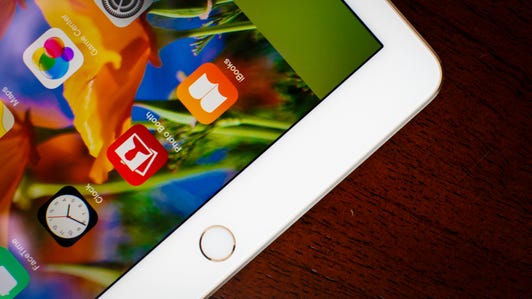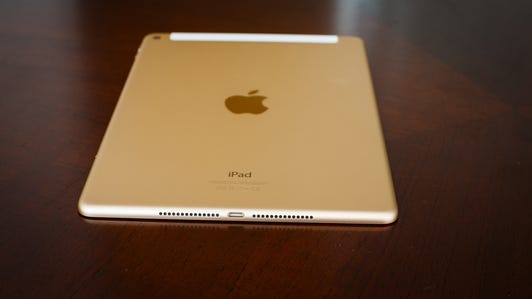
James Martin/CNET
The iPhone 6 didn’t just supersize the phone’s screen size. It also supersized Apple’s financial results.
The Cupertino, Calif., electronics giant on Tuesday reported the best sales quarter in its 38-year history, as demand for its newest smartphones, the 4.7-inch iPhone 6 and the 5.5-inch iPhone 6 Plus, soared beyond analysts’ expectations.
The company said it sold a record 74.5 million iPhones during the period, much higher than the 66.5 million estimated by analysts, according to a poll by Fortune. That’s 46 percent more devices than the record 51 million sold in the year-earlier quarter. This was the first full quarter of iPhone 6 and 6 Plus sales since their debut.
Apple also projected strong sales for the current quarter thanks to continued demand for its newest models, which went on sale in September. The iPhone’s success came at the expense of the iPad tablet, which posted its fourth consecutive decline as consumers opted for large phones over Apple’s tablet computers.
“We’d like to thank our customers for an incredible quarter, which saw demand for Apple products soar to an all-time high,” Apple CEO Tim Cook said Tuesday in a statement. “The execution by our teams to achieve these results was simply phenomenal.”
At the same time, Cook revealed Apple Watch will start shipping in April. Apple, which announced the device in September, earlier only said Apple Watch would hit stores in “early 2015.” The lowest end Apple Watch will cost $349.
“Development for Apple Watch is right on schedule,” Cook said.
Apple generates more than half of its revenue from its smartphone business and the iPad represents more than 10 percent. The fiscal first quarter, which ends in December, is typically Apple’s biggest quarter because of holiday sales and the introduction of the latest iPhones.
“They closed the one feature gap that they had, namely a larger screen, and blew the doors off on revenue and earnings,” Gartner analyst Van Baker said. “That said, they are increasingly dependent on iPhone revenues and that does pose increased risk.” In the period, about 70 percent of Apple’s revenue came from the iPhone. In the past, the iPhone and iPad combined typically made up about two-thirds of sales. But iPhone has been soaring as iPad has been slipping.
See also
- Apple’s 2015: Building on an already huge 2014
- Apple’s iPad sales are not so magical after all
- CNET’s initial thoughts on Apple Watch
The strong results stand in contrast to last year, when investors worried Apple’s best days were behind it. It seemed at that time that nothing could slow down rival Samsung’s quest to take mobile market share, while newcomers in emerging markets, such as Xiaomi in China, threatened Apple’s position. Apple is the world’s second-largest smartphone maker behind Samsung. Now, Samsung has found itself struggling to compete as customer demand soars for Apple’s new iPhones.
Apple also benefited from strong demand for Macintosh computers during the period. It sold 5.52 million Macs, up from 4.84 million a year ago and higher than the 5.51 million projected by analysts, according to a Fortune poll. Macs accounted for 9.3 percent of sales, and revenue from the computers reached a record high.
The increase in Mac sales comes as the rest of the PC market struggles. Worldwide PC shipments slid 2.4 percent to 80.8 million in the calendar fourth quarter, according to market tracker IDC. Apple held on to its new position as the fifth biggest computer vendor in the world, a title it first gained in the calendar third quarter of 2014 (which coincides with Apple’s fiscal fourth quarter) with then-record shipments of 5.5 million units. Apple controlled a much smaller chunk of the market in previous periods, but its sleek designs, such as the MacBook Air, have caught on with customers.
Shares closed Tuesday down 3.5 percent to $109.14, but rose 5 percent in after-hours trading.
As Apple advised in October, the company no longer breaks out sales for its retail stores or fading iPod media player. Store results are now spread among the various regions (including the Americas and Greater China). The iPod is lumped in with “other products,” including Beats headphones, the Apple TV streaming box and accessories. “Other products” will also include the highly anticipated Apple Watch, due in April. Apple also modified its ” iTunes /software/services” to simply “services” to encompass iTunes content and apps, software, cloud services and Apple Pay .
Slowing iPad demand
iPad remained the weak spot in Apple’s results. Tablet unit sales dropped 18 percent to 21.4 million, slightly below analysts’ predictions of 21.5 million, according to a poll by Fortune. Revenue totaled $8.99 billion, above the $6.94 billion generated from the Mac.
Large-screen smartphones, including the iPhone 6 Plus, are eroding demand for tablets; and consumers have held on to their iPads longer than their smartphones. Investors and analysts have questioned for months if the iPad’s declining shipments are a temporary hiccup or a troubling trend. Apple has long claimed iPad weakness is a “speed bump.”
iPad Air 2: Up close and personal with the latest iPad (pictures)






The company introduced its newest tablets — the iPad Air 2 and the iPad Mini 3 — in October, but analysts said the incremental changes, including faster processors, weren’t enough to attract buyers. Instead, customers either opted for older models or bought an iPhone 6, which has a larger screen than the 4-inch display of the iPhone 5. Many analysts expect Apple to soon introduce an iPad with a bigger screen.
The iPad tends to have strong sales in the December quarter as consumers scoop them up for holiday gifts. Apple posted its biggest period ever in fiscal 2013’s holiday quarter, with sales of 26 million iPads. However, iPad demand has fallen every quarter since then, and the first quarter of 2013 was one of only three quarters out of the past eight that iPad unit sales and revenue rose year over year.
Apple reached a deal with IBM in July to help push Apple devices and iOS apps to businesses, something that should help iPad sales. IBM will optimize its cloud-computing services — such as device management, security and analytics — for iOS. Last month the two companies introduced the first crop of apps for the airlines, telecommunications, insurance, banking and government industries.
Apple Watch is the first major new product category for Apple since the “magical” iPad in 2010. It’s also the first new push by the company under Cook’s tenure. Cook had promised for more than a year that Apple in 2014 would introduce and enter beyond its smartphones, tablets and computers. Apple Watch and the company’s new mobile-payments system, Apple Pay, meet that promise.
Apple reported that net income rose to $18 billion, or $3.06 a share, from $13.1 billion, or $2.07 a share, a year earlier. Analysts had expected earnings of $2.60 a share.
Sales for the period ended December 27 jumped 30 percent to $74.6 billion, well above the $67.69 billion projected by Wall Street.
Gross margin grew to 39.9 percent from 37.9 percent in the year-ago quarter. Analysts had projected 38.5 percent. Apple’s gross margin, a measure of sales after removing costs like manufacturing, has fallen since its high of 47.4 percent in early 2012 as customers opt for lower-cost devices.
For the fiscal second quarter, which ends in March, Apple projected revenue of $52 billion to $55 billion, largely in line with the $53.79 billion forecast by analysts, according to Thomson Reuters. Apple typically forecasts lower sales than analysts estimate.
Updated at 2:20 p.m. PT with details about Apple Watch.



